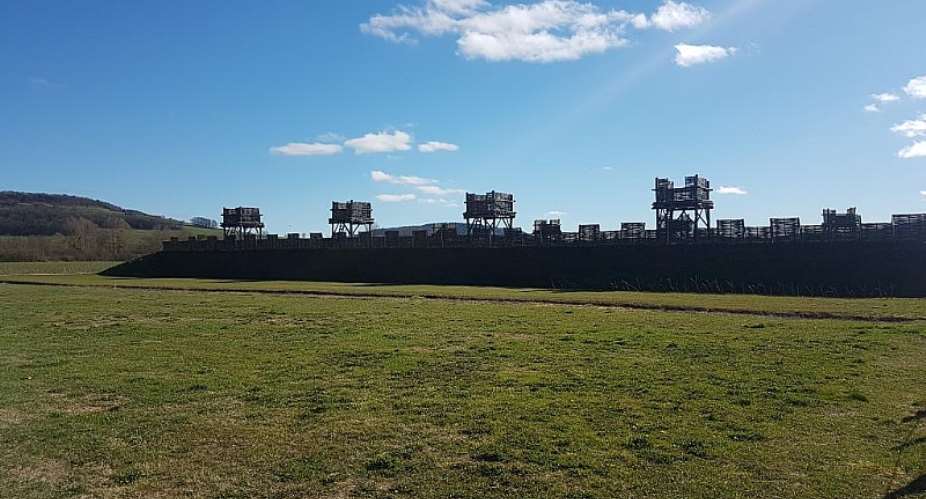A sign on the A6 motorway around 250 km southeast of Paris indicates the turn-off for Alesia MuséoParc. In 52 BC Alesia was where the Roman general Julius Caesar achieved one of his most significant military victories. And, in the process, Caesar created a French legend in the form of the defeated Gallic leader Vercingetorix.
“It was a decisive battle in Caesar's struggle for Gaul. The Roman victory effectively ended the war. Its second significance is its place in modern history in France where the battle and the site have an iconic place in modern French history and nationalism,” Professor Andrew Fitzpatrick of University of Leicester's School of Archaeology and Ancient History told RFI.
A circular building on the outskirts of the town Alise-Sainte-Reine (formerly the Gallic town of Alesia) awaits visitors. Called the interpretation centre, its form suggests the besieged Alesia, a town situated on a high hill (an oppidum) a couple of kilometers away.
Visitors can re-imagine the battle of Alesia through the artefacts, including weapons, films, maps and scale models displayed in the building. One can also experience the various stages of the battle through augmented reality. Binoculars pointed at important battle sites near the oppidum enable visitors to get a close-up of the landscape. A few moments later animations spring to life within the binoculars to relate the unfolding of the siege and the battle.
Perhaps the most striking feature of the museum is the reconstructed section of the two huge walls, inner and outer, that were built by Caesar's troops to besiege the oppidum but also to protect them from attacks by Gallic reinforcements. Made from earth with a wooden parapet, the two walls measured 15 and 21 kms in length respectively. The Roman camps were sited next to the walls.
As the reconstructed sections show, the 12-foot-high walls were protected by ditches. Rows of obstacles and traps were built in front of the wall to face the Gallic reinforcements. The Romans also had catapults trained on this area.
Professor Fitzpatrick says the construction of the first wall was standard practice in siege warfare for hundreds of years before Caesar. “Caesar was acting like a normal general of that time. There is an almost identical example to the siege of Alesia about a hundred years earlier in Spain. He was doing what was well known then.
“But it's also quite common for the besieged people to try to have the siege lifted. That is why Caesar had to build a second line of defence to protect the Romans from the Gaulish relief army that tried to break the siege. Although Vercingetorix was trapped inside Alesia, he summoned an enormous army to attack the Romans from behind,” he said.
Caesar's army managed to repel the attack from the relief army of the Gauls and routed Vercingetorix's forces. That led to the latter's surrender.
The reason why Caesar's victory is considered to be an outstanding military feat is because of its scale.
“Caesar's army, which wasn't more than 60,000 soldiers, was outnumbered by the army of the Gauls, which was said to amount to over 250,000. It is also the significance of the result - the Gauls were never able to put such a large army in the field ever again. It effectively ended the war. It was the turning point.”
But the battle of Alesia wasn't about Caesar alone. It produced a new hero in Vercingetorix. The Gallic leader's legendary status is fittingly manifested in the gigantic copper statue that is installed on the hill. The 6.6m-tall statue that stands on a 7 meter high column was commissioned by the French emperor Napoleon III in 1862 and was completed in 1865.
“In his commentaries, which are his account of the war, Caesar reports a speech by Vercingetorix that encourages Gauls to fight as a nation.
And that is something that has been picked up over the past 200 years by politicians in France, most notably by Napoleon III who tried to use it at the time when the modern French state was being created. The message was: 'this is what we can achieve as Gauls.' But you also see it being used by the former socialist president François Mitterrand,” Professor Fitzpatrick says.
Vercingetorix may have died, defeated, in a damp Roman dungeon. But his defiance of Rome turned him into a legend and a national hero of France.





 Tuesday’s downpour destroys ceiling of Circuit Court '8' in Accra
Tuesday’s downpour destroys ceiling of Circuit Court '8' in Accra
 SOEs shouldn't compromise on ethical standards, accountability – Akufo-Addo
SOEs shouldn't compromise on ethical standards, accountability – Akufo-Addo
 Father of 2-year-old boy attacked by dog appeals for financial support
Father of 2-year-old boy attacked by dog appeals for financial support
 Jubilee House National Security Operative allegedly swindles businessman over sa...
Jubilee House National Security Operative allegedly swindles businessman over sa...
 Nobody can order dumsor timetable except Energy Minister – Osafo-Maafo
Nobody can order dumsor timetable except Energy Minister – Osafo-Maafo
 Mahama wishes National Chief Imam as he clock 105 years today
Mahama wishes National Chief Imam as he clock 105 years today
 J.B.Danquah Adu’s murder trial: Case adjourned to April 29
J.B.Danquah Adu’s murder trial: Case adjourned to April 29
 High Court issues arrest warrant for former MASLOC Boss
High Court issues arrest warrant for former MASLOC Boss
 Align academic curriculum with industry needs — Stanbic Bank Ghana CEO advocates
Align academic curriculum with industry needs — Stanbic Bank Ghana CEO advocates
 Election 2024: We'll declare the results and let Ghanaians know we've won - Manh...
Election 2024: We'll declare the results and let Ghanaians know we've won - Manh...
